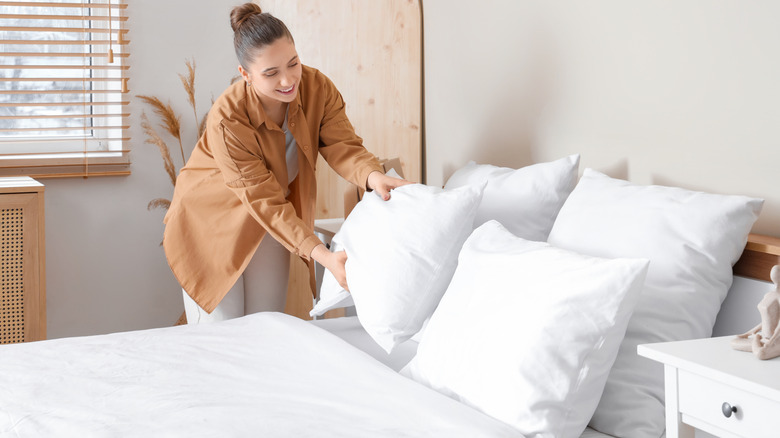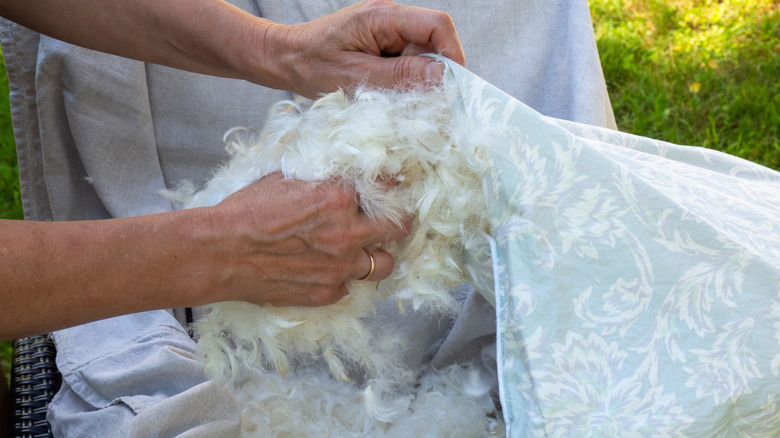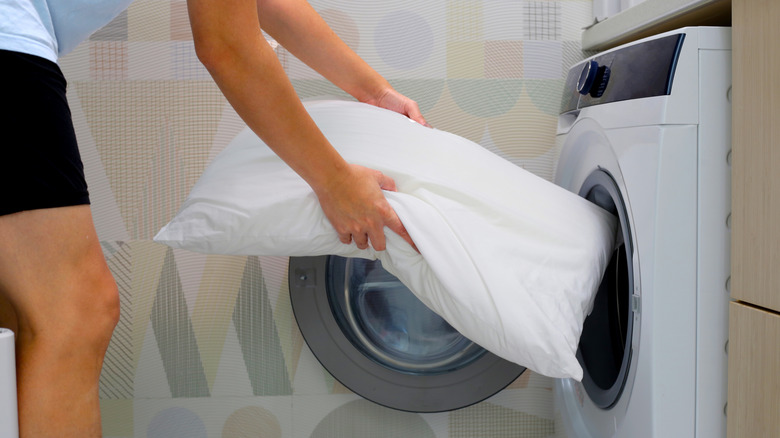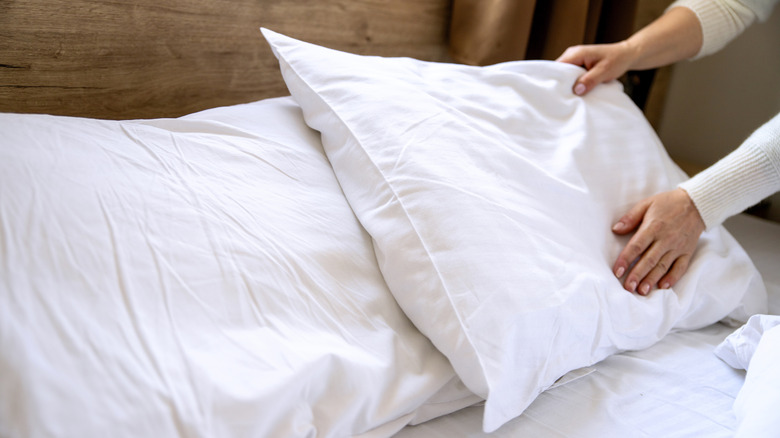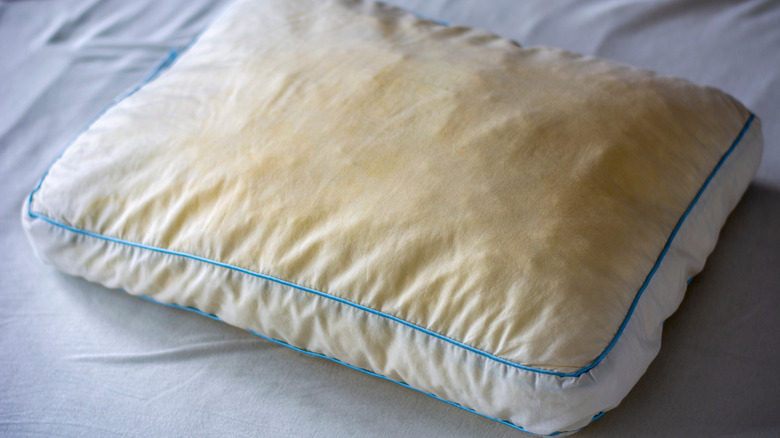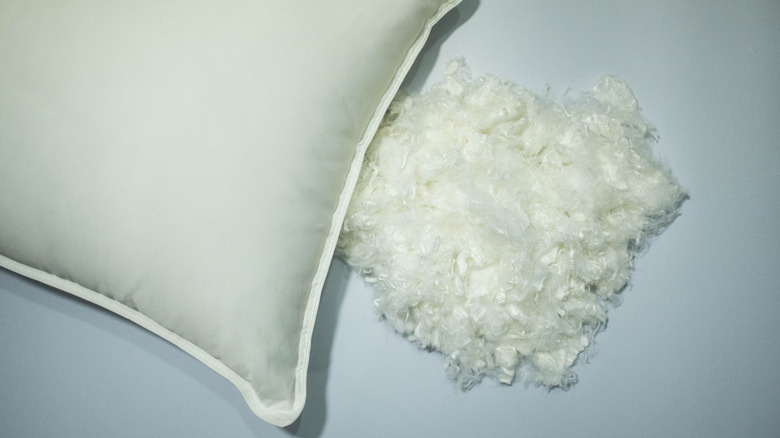What Are Down Alternative Pillows? (And The Benefits And Drawbacks You Should Know Before Buying)
There are many different things to consider when picking pillows for your bed, and depending on your preferences, down alternative pillows could be a good option, especially for those with allergies. While down pillows are filled with soft feathers from birds' undercoats, down alternative options are stuffed with synthetic material that's made to feel like real down feather pillows. Often, these pillows are filled with polyester microfibers or rayon, but on rare occasions they may contain some natural fibers, such as cotton or wool. Most of the time, down alternatives are totally synthetic. Though down alternative pillows aren't actually down, they're supposed to have the same luxurious qualities as those soft, feathery pillows.
Though down alternative pillows can be very similar to legitimate down, they can have some different qualities in their feel and breathability due to man-made fibers. When choosing between down pillows and down alternatives, you'll want to weigh factors like warmth, durability, cost, feel, and maintenance needs to decide which pillows will give you the best night's sleep and fit into your budget and lifestyle. While both of these pillow types can be luxuriously soft and comforting, there are benefits and drawbacks to down alternative pillows that are important to consider before buying them for your bedroom.
Down alternatives are much less expensive than the real thing
Opting for real down pillows is much more expensive than down alternatives, as these feathery pillows are often thought of as a luxury. On the other hand, down alternative pillows are typically easier on your wallet and will be the budget-friendly choice for ultimate comfort. Buying down alternative pillows is a great way to save a little money, while still purchasing quality pillows that will have a similar feel to pricier down options.
While down alternative pillows can be rather affordable, real down pillows are often about double the price. At The Company Store, a single down and feather pillow is over $100, while the down alternative pillow from the same brand is $54. Even at lower priced retailers, the difference in cost remains similar. For example, a Casaluna down alternative pillow from Target is just $25, but the down version is about $45. For those that don't have extra to spend on bedding, down alternative pillows are a fantastic choice that'll cost you about half as much as the real deal while still providing you with luxuriously comfortable bedding.
Down alternative pillows are more hypoallergenic
When you have allergies, waking up stuffy and uncomfortable from your pillow can be an absolute nightmare. Luckily, down alternative pillows don't have this problem. Though certain down pillows are touted as hypoallergenic and the feathers are thoroughly cleaned, some people may be allergic to the actual feathers inside the pillow. If you have more severe allergies or issues like asthma, down feathers could be a bad choice for a good night's sleep. This is sometimes because bird feathers have antigens that irritate some people's lungs. Since down alternatives are filled with synthetic fibers, they are less likely to cause allergic reactions. For people with troublesome allergies, down alternative pillows are the safest and best option to breathe easy during sleep.
Oftentimes, dust mites can be the reason you're allergic to your pillow rather than the actual stuffing it contains. While real down is more likely to have issues with dust mites, down alternatives are often somewhat resistant to dust mites. Additionally, down alternatives might hold up better against mildew and mold as well. Some of these hypoallergenic qualities could be partially due to the fact that alternatives are easier to wash than down pillows, allowing you to clean them more frequently.
Down alternatives are vegan and don't use materials from real animals
If you're trying to be more cruelty-free and avoid buying products that contain materials from animals, down alternative pillows are the way to go. Real down can be sourced from various kinds of birds, such as geese, ducks, and sometimes swans, and comes from the soft, insulating feathers on the animals' chests. High quality down alternative pillows will still give you a soft, comfortable place to rest your head with a feeling that's similar to real feathers, but without any birds involved.
Unfortunately, a lot of the down used to make pillows and other bedding comes from birds in meat industries, and unethical procedures like live-plucking may be practiced. If you're someone who's passionate about animal welfare, opting for alternative, synthetic pillows will ensure your bedding is vegan. While some companies track where their down comes from and try to source from more ethical options for their feathers, they could be more difficult to find or include a bigger price tag, making alternative pillows the best budget-friendly option for cruelty-free bedding.
Down alternatives can go straight into your washing machine
When it's time to give your pillows a much-needed deep clean, having down alternative pillows makes the job much easier than real down. Down bedding often gives off a noticeable odor when it gets wet during washing, prompting some people to have their down pillows professionally cleaned. Synthetic alternatives, by contrast, can be tossed into the washer and tumble-dried with ease—offering a low-maintenance option that takes the hassle out of pillow care.
Down can sometimes be washed with soap and laundry detergent, but besides the smell you also have to be much gentler with this natural material. While down alternatives can be washed in your machine without harm, real feather pillows really shouldn't be cleaned in a washer with an agitator, as they can get clumpy. In some cases, you may even have to wash down pillows in the bathtub, making alternatives the easier pillow to clean. Even if you purchase down alternative pillows, it's still a good idea to read the care label before washing. Most of the time, you can wash them on a gentle cycle with cool water, followed by a low heat tumble dry. Throwing a couple of dryer balls in with your down alternative pillow could help to fluff it up.
Real down can be more durable than the alternative options
While some higher quality down alternative pillows have the potential to last for a long time, others aren't as durable as pillows composed of real feathers. Down pillows might last for many years when properly cared for, but alternative materials can wear down more quickly and might have to be replaced more often. Within a couple years, down alternative pillows can start to lose their supportive shape, and if you want a pillow that stays nice for a long time, these pillows aren't the best choice compared to actual down.
The durability of down pillows could be part of why they're set at higher prices than alternative materials; however, if your down alternative pillows aren't lasting, frequently replacing them means you may end up spending more on pillows over time. If you want to opt for a down alternative for the lower cost but are worried about them wearing out quickly, try looking for higher quality synthetic down pillows with a higher fill weight and loft (fluffiness), and properly caring for them.
Though down alternatives are made to feel like down, they're not quite the same
Down alternative pillows with higher quality synthetic stuffing are designed to have almost the same softness and support of down options, making them an easy way to make your uncomfortable bed cozier; however, the entirely man-made fibers of these pillows have a slightly different feeling than laying your head on a bed of feathers. While real down is rather lightweight, down alternatives tend to be a bit heavier, making the pillow somewhat firmer as well. In some cases, the firmness of a down alternative pillow can provide a little more support.
On the other hand, this difference in material could also cause your down alternative pillows not to feel as plush or fluffy as actual down. If you're someone who loves a soft, fluffy pillow that's a bit more flexible, you may want to reconsider buying a down alternative pillow, but for those who need a little extra support or sleep on their side, these synthetic pillows are a great option. Though there may be a bit of a difference in the pillows' plushness, both down alternative and down feather pillows are sold in different weights and varieties of firmness, so you can find the right fit for you.
Down alternatives pillows may feel cooler than real down
Though down materials are known for their breathability, you should probably opt for a down alternative if you're someone who's constantly flipping your pillow to the cold side. Down has a tendency to retain heat, which means it might not be the best option for people who run hot at night. Down alternative pillows, on the other hand, won't stay as warm and will help keep you cool all night long.
The polyester fibers of down alternative pillows are made to have good airflow, which is why they don't usually retain as much heat. Real down feathers are meant to keep birds warmer in the winter and therefore have an insulating effect that down alternatives don't replicate. If it's difficult for you to get comfortable at night because you feel too hot, going with a down alternative pillow might just help you get a cooler, better night's sleep.
Down alternative pillows are less likely to yellow
While down pillows are often touted for their durability, they don't handle moisture well. Even if you avoid washing your down bedding with water, yellow stains can eventually develop from the pillow coming into contact with moisture from your sweat, damp hair, and drool. Luckily, down alternative pillows' microfiber filling can be better at handling moisture and have less of a chance of developing the same ugly, yellowing effect as natural fibers.
Oils from your lotions, hair products, and even your skin can also cause down pillows to yellow, and even the humidity in your home could end up affecting their color. Just like how you should avoid putting these types of pillows in your washing machine because the wet feathers can create a smell, other types of moisture are rough on real down as well. This is why down alternatives can be a great option for those who struggle with yellow stains constantly emerging on their pillows or if you want to try to keep your pillows whiter with time.
If you get cold at night, down alternatives might not stay as warm
Just as you should consider whether down may be too heat-insulating for you if you run hot, down alternatives can feel down-right cold if you tend to get chilly in bed. Down alternative material is often considered all-season bedding because it does not trap heat as well as real down. While this can be a great thing for hot sleepers or during hotter summer nights, it may also be a drawback if you tend to get cold. If you are always shivering and bundling up at night, choosing a down alternative pillow won't help to keep your bed any warmer and could end up being a mistake when buying pillows.
While the lack of heat retention in down alternatives will be a benefit for some, people who live in places with extremely bitter winters might want a pillow that holds in a bit more heat and has a more insulating material like down feathers. The great airflow of the synthetic polyester stuffing is helpful for hot sleepers, but it also might not keep your pillow warm enough. Though alternative and regular down pillows can be very similar, temperature regulation is an important factor in choosing the right pillow for your bed.
Down alternatives are usually made of synthetic polyester materials that aren't as eco-friendly
When weighing everything you need to know before you buy pillows, you might want to think about the environmental impact behind the production of your bedding. If you're more passionate about sustainability, knowing how your pillows are made could affect your decision, and the synthetic material used to fill down alternatives might not be the most eco-friendly. As the fibers are produced in factories, their manufacturing could have environmental impacts like chemical waste.
While animal treatment can be a big factor in considering down pillows, the feathers they're made of are natural and biodegradable, making these pillows more eco-friendly compared to alternatives. Additionally, the shorter lifespan of down alternatives could lead to you replacing them faster and more pillows being thrown away, only to end up in landfills. Though down alternatives are sometimes made from more natural materials like cotton or wool, this is not as common as polyester microfiber filling and you might want to consider the environmental implications of synthetic fibers before buying your pillows.
Down alternatives can be great for any sleeping position
Whether you like to fall asleep on your side, back, or stomach, down alternative pillows can be a great way to give your bed a luxury hotel feel. The plush, fluffy texture and lightweight qualities of real down pillows may not offer as much firm support. While this can be nice for some back and stomach sleepers, the boost of a little extra support from down alternatives makes them especially good for people who sleep on their side. Even if you prefer to sleep in a different position, down alternative pillows come in various levels of firmness, allowing you to choose the perfect feel for however you're most comfortable.
If the firmness of a typical down alternative pillow is a little too much for you when sleeping on your back, try choosing one with a medium softness level for a little extra fluff. Because firmer down alternatives aren't as flexible, stomach sleepers might prefer one that's as soft as possible. No matter which sleeping position suits you best, you'll be able to find a down alternative that accommodates it.
Some down alternative pillows may get lumpy
While down alternative pillows with better quality stuffing might not become lumpy quickly, lower quality synthetic fillings have the potential to clump up with time and use. This is because the loose puffs of polyester fluff will bunch together, making your pillow misshapen and uneven. Taking care of your synthetic pillows and frequently fluffing them up will help to prevent lumpiness and ensure your pillows stay comfortable and soft for longer.
Sometimes, tons of continual machine washing, washing your pillow incorrectly, or a lot of exposure to moisture can exacerbate clumping and lumpiness in your down alternative pillow. To keep your pillows in tip-top shape and avoid issues with clumping, use dryer balls or tennis balls when running your bedding through the dryer. The balls will help to fluff your pillow as it dries, working out the lumps. Down alternative pillows may only last for a few years, and as they wear out, clumping is natural. When your pillow gets too lumpy and uncomfortable, it's time for a replacement.
